5-Layer Mini Forest in 5 Acre Land Boosts Karnataka Farmer’s Annual Income to 25 Lakh!
Zero budget natural farming is also helping Krishappa Gowda save 90% water and get high yields throughout the year.
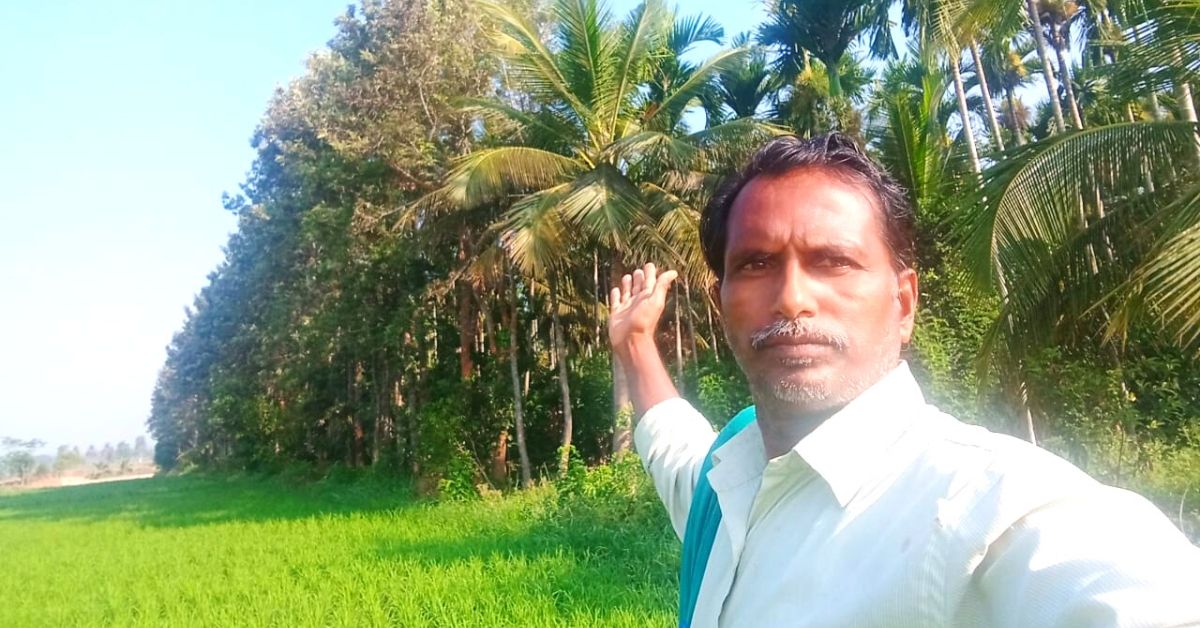
Fifteen years ago, Krishnappa Dasappa Gowda, a paddy farmer from Mysuru’s Pannur village, had no idea about Zero Budget Natural Farming (ZBNF). Continuing his hereditary occupation, the farmer grew paddy after season, using chemical fertilisers and pesticides.
Although the 25-acre farm demanded substantial investments to sustain the crops and gave less yield, it provided a decent livelihood.
However, a meeting in 2005 with Subhash Palekar, fondly known as ‘Krishi ka Rishi’ in farming communities across India, changed everything. Overnight, Gowda ditched chemicals and pesticides and shifted to ZBNF.
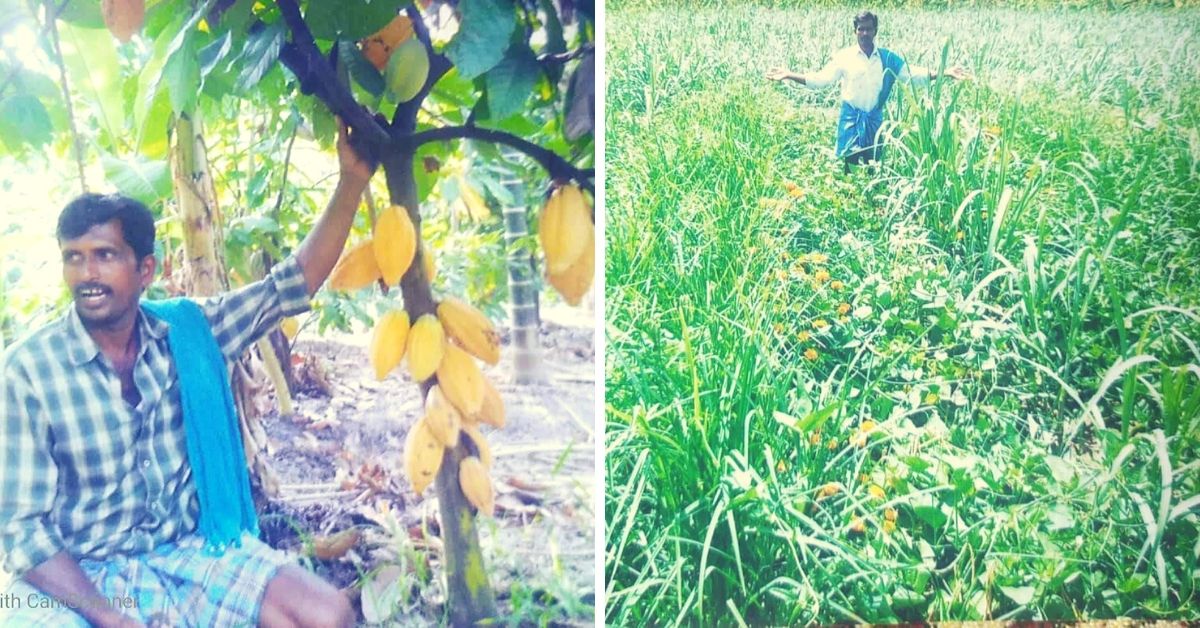
Today, Gowda successfully grows more than 170 varieties of trees using natural methods, on five acres (of the total 25 acres). What’s truly remarkable is that the forest-style farming method has increased the 10th-pass farmer’s annual income to 25 lakh!
“ZBNF has drastically improved my yield and soil fertility. Thanks to the diversified farm, my earnings are not dependent on the performance of a single crop any more. Plus, due to the cropping techniques, water consumption is only 10 per cent of conventional farming. The switch has also improved my health—I used to suffer from terrible skin-related ailments, but not anymore” Gowda (51) tells The Better India.
Before explaining the secret behind his high yield and income, it is crucial to understand ZBNF.

It is a self-sustaining model developed by Palekar after the agriculturist learnt how chemical fertilizers and pesticides deteriorate the soil fertility eventually leading to health problems for those who consumed the grains and vegetables.
As per this method, crops are grown naturally by replacing harmful fertilisers with biological ones like cow dung, cow urine, jaggery and pulse flour. It requires a minimal monetary investment, thus increasing the farmer’s income.
Cows are an integral part of the harvesting circle as they help in grazing and their waste (urine and dung) is used to coat the seeds, and this is known as the beejamrutham process. Meanwhile, the jeevamrutham process (where cow dung and urine is mixed with jaggery and flour) increases the microbes in the soil and keep away the pests.
“An acre of land needs ten kilos cow dung every month. Since the average cow gives 11 kilos of dung a day, dung from one cow can help fertilise 30 acres of land,” explains Gowda.
Making Profits In the First Year
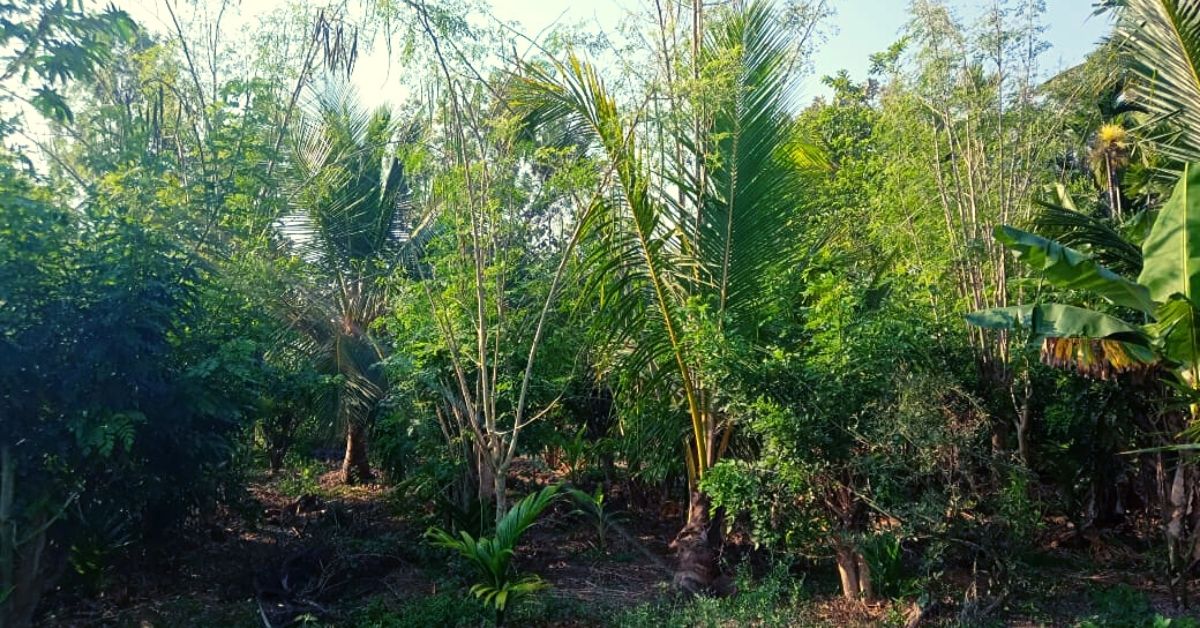
Gowda started with ZBNF on just an acre of land as an experiment. However, getting rid of any kind of dependence is not easy, and the same is true for soil and plants. His crops did not take well to the home-made fertiliser, and nearly 50 per cent of them got damaged in the initial period of gestation.
But, he did not lose heart and spent months understanding the requirements of the soil and plants. During this period, he figured out the health of his farm and chose seeds that would suit the weather and soil conditions of the field.
“I was in constant touch with Palekar sir. I implemented each of his suggestions and patiently waited for the results. After a year of hard work and mocking from fellow farmers, the patch of land bloomed with fruits, grains and vegetables. I was shocked to see multiple plants like banana, pulses, marigold, onion, pumpkin thriving together,” he informs.
The massive profits further validated the success within the first three months of production.

“Using a multi-cropping method, I planted several plants with an investment of merely Rs 5,000 and got a profit of Rs 16,000.”
He also used cow dung to revive the fertility and nutrient value of soil.
“Cow dung has crores of beneficial microorganisms that decompose the dried biomass on the soil and convert it into ready-to-use nutrients for plants. This process is found in forests where healthy plants grow without any chemical. Since most farmers use chemicals, it kills the microorganisms,” says Gowda, explaining the science behind this step.
On finding success, he implemented this method on five acres over the years.
Five-Layer Farming Model on One Acre
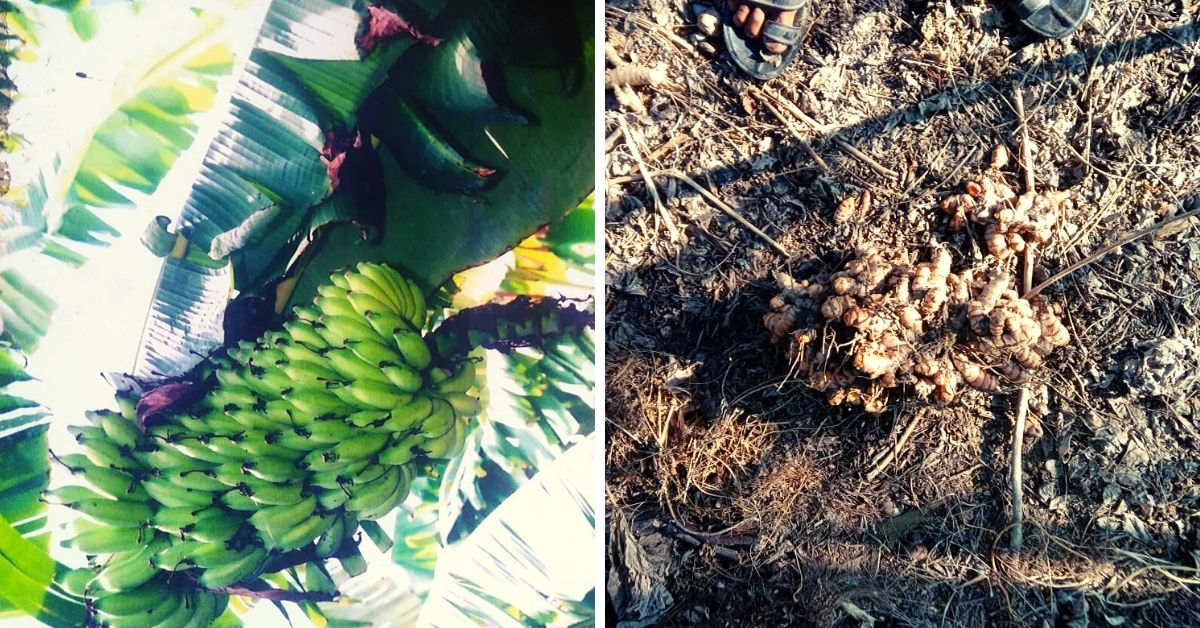
Under this method, five types of crops with varying heights and rooting patterns are cultivated together at the same time. Multilayer cultivation optimally utilises space horizontally and vertically
From long and medium-height trees, bushes, creepers to grass, Gowda grew them all, and here’s his multi-cropping model:
- For the tallest layer, he planted 30 coconut trees, and since one tree gives around 300 coconuts in a year, that amounts to a total income of Rs 1.80 lakh.
- On a rotational basis, Gowda plants either 30 trees of Orange or Mosambi (Sweet Lime). “One tree gives a minimum of 15 kilos and a maximum of 100 kilos. I earn around Rs 1.5 lakh from the middle layer,” says Gowda.
- 200 banana and 400 areca nut trees are planted as the third layer. Annually, he earns around Rs 3 lakh (Rs 60,000 from banana trees and Rs 2.4 lakh from areca nut) from this layer.
- Just like the second layer, the fourth layer also works on a rotational basis. He either plants 200 trees of cocoa or coffee and each tree produces 2 kilos. Additionally, he has also planted 200 gliricidia, 200 vanilla and 400 black pepper trees.
- In the final layer, Gowda planted ginger and turmeric. “Annually, I get up to ten quintals of turmeric. I sell one quintal starting from Rs 200 to 2000 depending on the variety.”
Gowda also grows other plants such as drumsticks, spinach, bottle guard, brinjals, lemons, pulses and so on.
Per acre, he earns around Rs 5 lakh, which makes it a total of Rs 25 lakh from five acres.
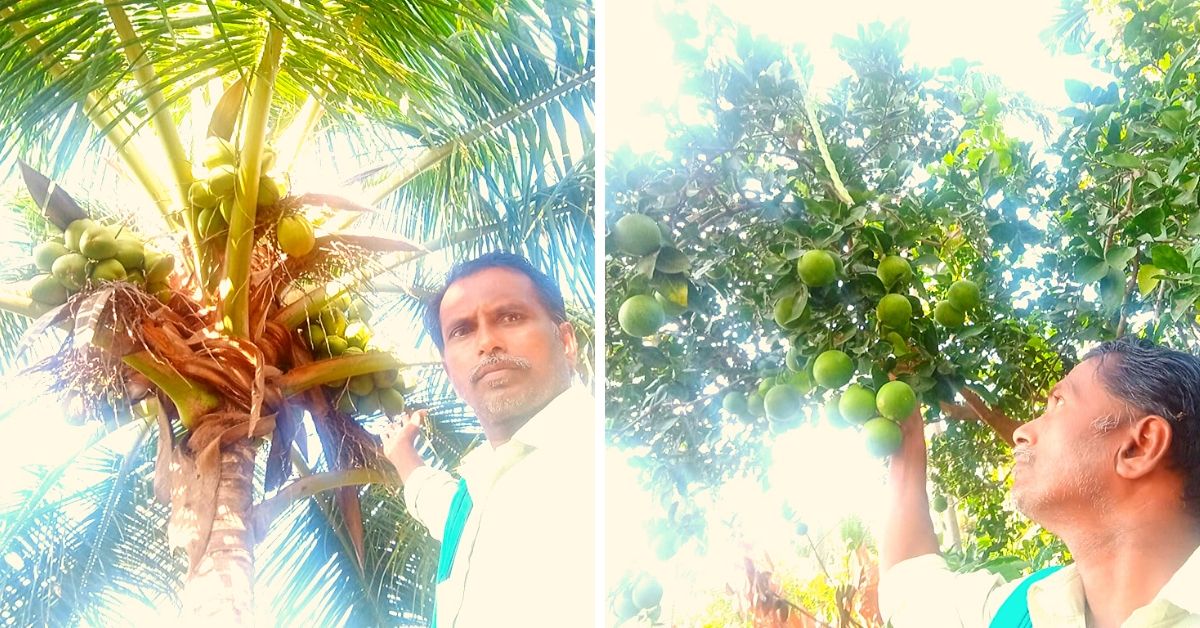
The Four Pillars of ZBNF
Gowda abides by four cultivation principles that act as pillars to sustain the five-layer model. These are jeevamrutham, beejamrutham, mulching and maintaining the water ratio.
As mentioned earlier, while jeevamrutham provides nutrients for plant growth, beejamrutham (a mix of cow dung, urine, lime and water) protects seeds and roots from the fungus.
The process of mulching is very crucial when it comes to soil health, “It retains moisture in the soil, prevents weed growth and promotes biodiversity,” he says.
Before sowing, Gowda digs a pit with a depth of three feet and fills it with tree branches, fruit residues, coconut leaves and covers it with sand, “This helps in absorbing nitrogen from the air and gives it to the plants.”
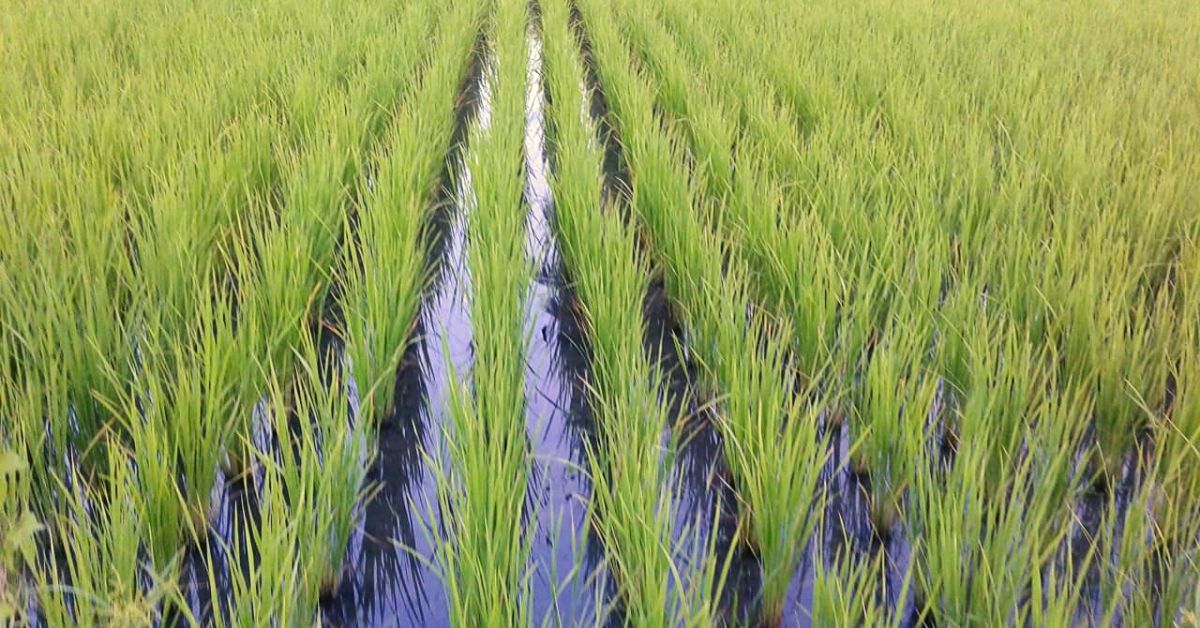
As for water, Gowda says that his land is double-wet and rain-fed. He adds six litres of water to one kilo of humus (decomposed organic matter) that suffices an acre, “The nutrient-rich soil produces carbon and nitrogen that prevents evaporation and I save lakhs of litres of water.”
Conclusion
If there is one thing Gowda has learnt in the last 15 years, it is to treat the farm like a forest.
“Forests thrive on their own with any chemicals or constant watering. I have inculcated the same ecosystem on my farm. So, all that my team and I do is harvest the plants. My expenses have drastically reduced, and I only spend money on purchasing new seeds and on hiring labour,” he says.
Gowda strongly believes that adopting the ZBNF model can reduce agriculture-related issues like heavy credit, chemicals, monetary loss and most importantly, prevent farmer suicides.
If you have any queries about ZBNF, you can get in touch with Krishnappa Gowda at 9880587545
Also Read: Rs 5 Lakh to 50 Lakhs: Haryana Engineer Scripts Success in Zero-Budget Natural Farming!
Like this story? Or have something to share?
Write to us: [email protected]
Connect with us on Facebook and Twitter.
If you found our stories insightful, informative, or even just enjoyable, we invite you to consider making a voluntary payment to support the work we do at The Better India. Your contribution helps us continue producing quality content that educates, inspires, and drives positive change.
Choose one of the payment options below for your contribution-
By paying for the stories you value, you directly contribute to sustaining our efforts focused on making a difference in the world. Together, let’s ensure that impactful stories continue to be told and shared, enriching lives and communities alike.
Thank you for your support. Here are some frequently asked questions you might find helpful to know why you are contributing?


This story made me
- 97
- 121
- 89
- 167











